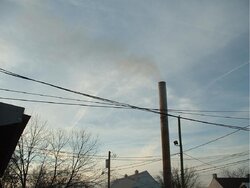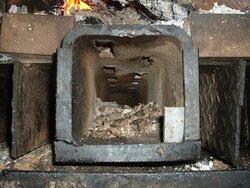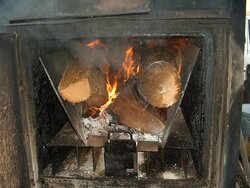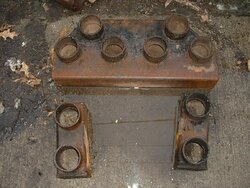I don't recall the name of the company making the gasifier outdoor unit, but a google search should turn it up. They have video of it operating on the web site. Looks good!
I think that OWB manufacturers fall into a few different categories. Some lack the expertise and know-how to produce a gasifier version, being small manufacturing shops that probably didn't even design the unit they are manufacturing. Most produce what is easiest and offers the largest profit margin. Gasifiers require refractory materials that add a level of complexity, cost, weight, etc., that many aren't equipped to deal with.
I think an argument could also be made that OWB companies produce what the market is asking for. Gasification is still relatively unknown in the US in the mainstream. As the buying public becomes more aware of the benefits, companies will move in to meet the demand. Already several OWB companies have either introduced a gasifier or are about to....
I also believe that the market for wood burning heaters, while interest is up with the current energy market situation, will never be that large as the majority of Americans have become too use to the convenience of oil, gas, etc., and aren't interested in tending a boiler. Consequently, in the US, you end up with smaller manufacturers lacking the engineering resources and R&D;budgets necessary to develop a more sophisticated product.
I wouldn't think OWB manufacturers would be interested in retrofitting existing boilers for liability reasons, as a start.
I see no reason why, if starting with the right boiler, that one could not convert it to a gasifier. Look at the Greenwood or Seton, for examples-they aren't much more that a refractory lined conventional boiler. With the right cast refractory pieces and a little experimenting with air flows and nozzle sizes, it shouldn't be out of reach for someone willing to spend a little time experimenting. The gasification process has some "play" in it which means one doesn't have to hit everything right on the head for it to work...Remember that masonry heaters have used gasification for hundreds of years, with no moving parts. Part of what makes the ECO and the like so much more sophisticated is the need to idle. If you simply wanted a box to gasify fuel at an all out burn, a lot of the hardware is not necessary.
I think that OWB manufacturers fall into a few different categories. Some lack the expertise and know-how to produce a gasifier version, being small manufacturing shops that probably didn't even design the unit they are manufacturing. Most produce what is easiest and offers the largest profit margin. Gasifiers require refractory materials that add a level of complexity, cost, weight, etc., that many aren't equipped to deal with.
I think an argument could also be made that OWB companies produce what the market is asking for. Gasification is still relatively unknown in the US in the mainstream. As the buying public becomes more aware of the benefits, companies will move in to meet the demand. Already several OWB companies have either introduced a gasifier or are about to....
I also believe that the market for wood burning heaters, while interest is up with the current energy market situation, will never be that large as the majority of Americans have become too use to the convenience of oil, gas, etc., and aren't interested in tending a boiler. Consequently, in the US, you end up with smaller manufacturers lacking the engineering resources and R&D;budgets necessary to develop a more sophisticated product.
I wouldn't think OWB manufacturers would be interested in retrofitting existing boilers for liability reasons, as a start.
I see no reason why, if starting with the right boiler, that one could not convert it to a gasifier. Look at the Greenwood or Seton, for examples-they aren't much more that a refractory lined conventional boiler. With the right cast refractory pieces and a little experimenting with air flows and nozzle sizes, it shouldn't be out of reach for someone willing to spend a little time experimenting. The gasification process has some "play" in it which means one doesn't have to hit everything right on the head for it to work...Remember that masonry heaters have used gasification for hundreds of years, with no moving parts. Part of what makes the ECO and the like so much more sophisticated is the need to idle. If you simply wanted a box to gasify fuel at an all out burn, a lot of the hardware is not necessary.





